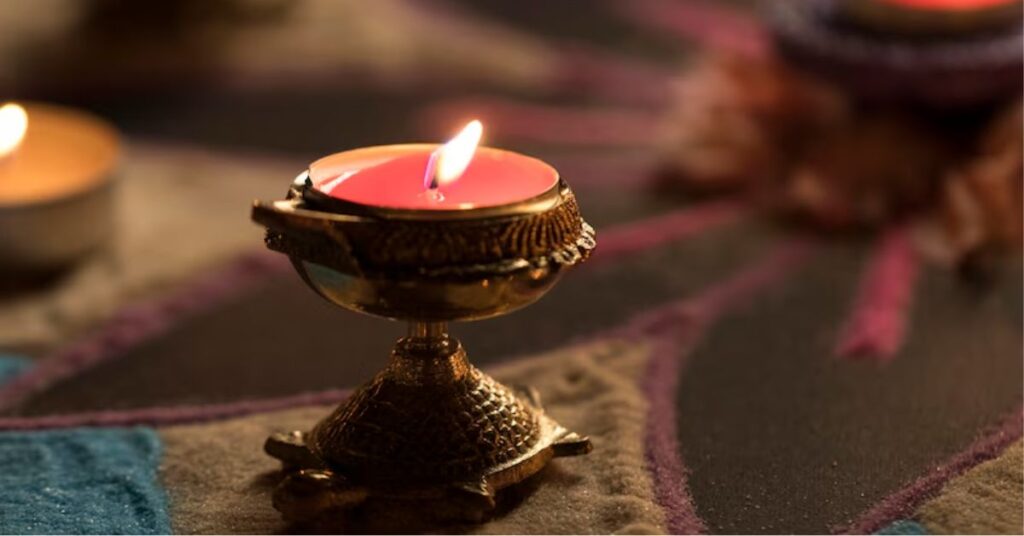In the vibrant tapestry of Indian culture, few objects hold as much significance and beauty as the humble diya. These small oil lamps have been lighting up homes, temples, and festivals for centuries, carrying with them a rich history and deep spiritual meaning. From the simplest clay diyas to intricately designed brass diyalamps, these luminous vessels play a central role in Indian traditions, especially during the festival of Diwali. This article delves into the fascinating world of diyas, exploring their origins, varieties, and the special place they hold in Indian hearts and homes.
The Essence of Diyas
What is a Diya?
At its core, a diya is a small oil lamp traditionally used in India for religious purposes and festive occasions. Typically made from clay, these lamps consist of a shallow dish with a protruding lip where a cotton wick is placed. The dish is filled with oil or ghee, which fuels the flame.
Spiritual Significance
– Symbol of knowledge and enlightenment
– Representation of the inner light that dispels darkness
– Offering to deities in Hindu rituals
The flame of a diya is often seen as a metaphor for the human soul, pure and unwavering in its devotion. Lighting a diya is believed to ward off negative energies and invite prosperity and good fortune into one’s life.
The Evolution of Diyas
While the basic concept of the diya remains unchanged, its forms have evolved over time to include a wide variety of materials, designs, and purposes.
Traditional Clay Diyas
– Handcrafted by skilled artisans
– Eco-friendly and biodegradable
– Often left undecorated or adorned with simple patterns
Modern Variations
1. Brass diyas: Durable and ornate
2. Silver diyas: Associated with luxury and auspiciousness
3. Glass diyas: Contemporary and decorative
4. Electric diyas: Safe alternatives for modern homes
This evolution reflects the adaptability of Indian traditions, blending ancient customs with contemporary needs and aesthetics.
Diyas for Diwali: The Festival of Lights
The Central Role of Diyas in Diwali Celebrations
Diwali, also known as Deepavali, is perhaps the most important festival where diyas take center stage. The name itself means “row of lights,” highlighting the integral role these lamps play in the celebrations.
Significance of Diwali Diyas
– Welcoming the goddess Lakshmi, bringer of wealth and prosperity
– Commemorating Lord Rama’s return from exile
– Symbolizing the triumph of light over darkness, good over evil
During Diwali, homes and public spaces are adorned with countless diyas, creating a breathtaking spectacle of light that symbolizes hope, renewal, and spiritual awakening.
Creative Diya Arrangements for Diwali
The arrangement of diyas during Diwali is an art form in itself, with families and communities coming together to create stunning displays.
Popular Diya Decorations
1. Rangoli designs filled with lit diyas
2. Floating diyas in water bodies
3. Diyas placed along staircases and windowsills
4. Intricate patterns formed by multiple diyas
These arrangements not only serve a decorative purpose but also hold deep symbolic meaning. For instance, diyas placed at entrances are thought to welcome positive energies and ward off evil spirits.
The Craftsmanship Behind Diyas
Traditional Diya Making
The art of crafting diyas, especially traditional clay ones, is a skill passed down through generations. This ancient craft not only preserves cultural heritage but also provides livelihoods for many rural artisans.
The Process of Clay Diya Production
1. Clay preparation: Selecting and mixing the right type of clay
2. Molding: Shaping the clay into the characteristic diya form
3. Drying: Allowing the shaped diyas to dry naturally
4. Firing: Baking the diyas in kilns to harden them
5. Decorating (optional): Adding colors or patterns to enhance appeal
Each step requires skill, patience, and an understanding of traditional techniques. The handmade nature of these diyas imbues them with a unique character and connects users to centuries of tradition.
The Art of Brass Diya Making
Brass diyas represent a more permanent and ornate category of these traditional lamps. The creation of a brass diya involves intricate metalwork and often results in heirloom-quality pieces.
Crafting Brass Diyas
1. Design conceptualization
2. Mold creation
3. Metal casting
4. Polishing and finishing
5. Engraving or embellishing (for more elaborate pieces)
Brass diyas are prized for their durability and the warm, golden glow they cast. Many families pass down brass diyas through generations, making them treasured family heirlooms.
Diya Lamps in Modern Indian Homes
Incorporating Diyas in Contemporary Decor
As Indian interior design evolves, so does the role of diyas in home decor. These traditional lamps are finding new life as stylish accessories that blend cultural heritage with modern aesthetics.Creative Uses for Diya Lamps
– Centerpieces for dining tables
– Ambient lighting in living rooms
– Decorative elements in home offices
– Mood lighting for outdoor spaces
Designers are reimagining diyas in innovative ways, creating pieces that serve both functional and decorative purposes year-round, not just during festivals.
Electric and LED Diyas: A Modern Twist
With safety concerns and practicality in mind, electric and LED diyas have gained popularity, especially in urban settings.
Advantages of Electric Diya Lamps
1. Safety: No risk of fire or burns
2. Convenience: Easy to use and maintain
3. Longevity: Can be used repeatedly without replacement
4. Versatility: Available in various designs and colors
While purists may prefer traditional oil lamps, electric diyas offer a practical alternative that allows for the continuation of diya traditions in modern contexts.
The Global Appeal of Indian Diyas
Diyas Beyond Borders
The charm of diyas has transcended cultural and geographical boundaries, finding admirers worldwide.
International Adoption of Diya Culture
– Use in yoga and meditation practices globally
– Incorporation in non-Indian festivals and celebrations
– Growing popularity as decorative items in Western homes
This global appreciation of diyas speaks to their universal appeal as symbols of light, hope, and spirituality.
Diyas as Cultural Ambassadors
Diwali celebrations in countries with significant Indian diaspora populations have introduced diyas to diverse communities, fostering cultural exchange and understanding.
Diya-Lighting Ceremonies Around the World
1. New York’s Times Square Diwali celebration
2. London’s Trafalgar Square Diwali festival
3. Singapore’s Little India Deepavali light-up
These events not only celebrate Indian culture but also create bridges of understanding between different communities, with diyas serving as luminous symbols of unity and shared humanity.
Conclusion
From the humble clay diya to elaborate brass diya lamps, these small vessels of light continue to hold a special place in Indian culture and beyond. As we light diyas for Diwali or use them in our daily lives, we connect with a tradition that spans millennia, bridging the past and present. Whether used in religious ceremonies, festive celebrations, or modern home decor, diyas remain powerful symbols of hope, knowledge, and spiritual enlightenment. In an ever-changing world, the warm glow of a diya serves as a constant reminder of the enduring light within us all, inviting us to shine brightly and spread warmth wherever we go.







